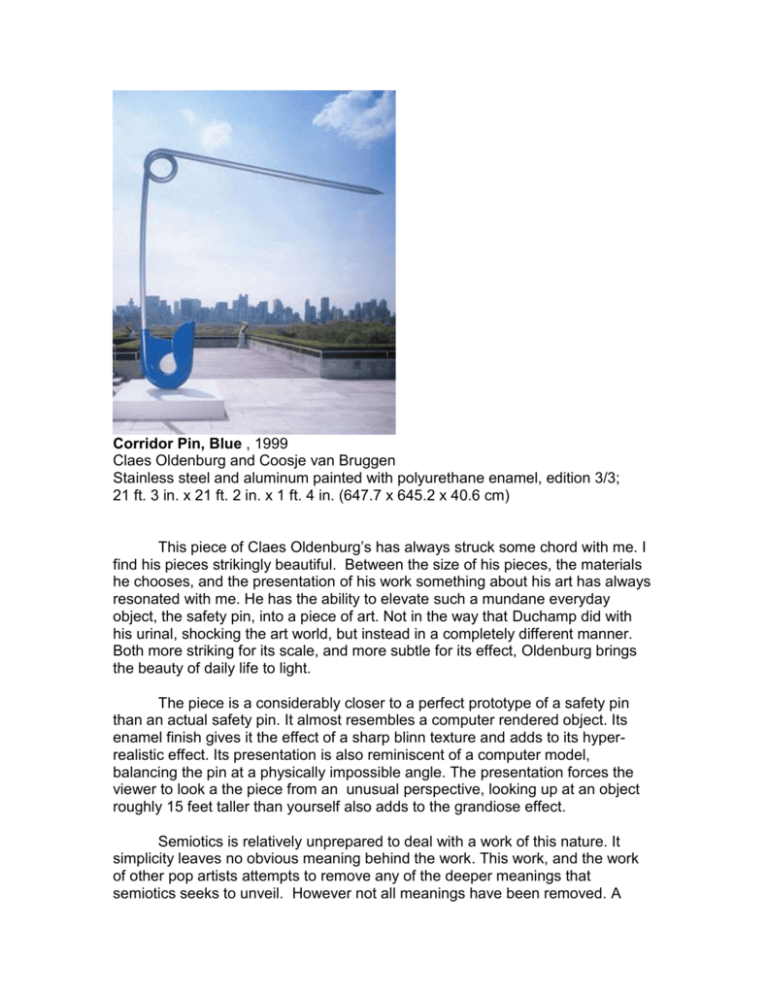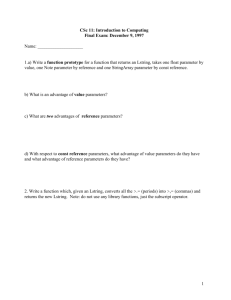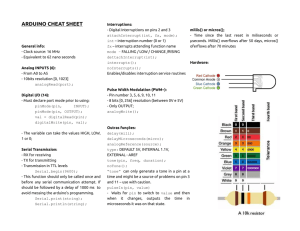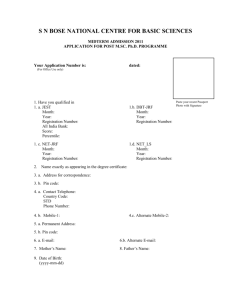Claes Oldenburg and Coosje van Bruggen, "Corridor Pin, Blue, 1999"
advertisement

Corridor Pin, Blue , 1999 Claes Oldenburg and Coosje van Bruggen Stainless steel and aluminum painted with polyurethane enamel, edition 3/3; 21 ft. 3 in. x 21 ft. 2 in. x 1 ft. 4 in. (647.7 x 645.2 x 40.6 cm) This piece of Claes Oldenburg’s has always struck some chord with me. I find his pieces strikingly beautiful. Between the size of his pieces, the materials he chooses, and the presentation of his work something about his art has always resonated with me. He has the ability to elevate such a mundane everyday object, the safety pin, into a piece of art. Not in the way that Duchamp did with his urinal, shocking the art world, but instead in a completely different manner. Both more striking for its scale, and more subtle for its effect, Oldenburg brings the beauty of daily life to light. The piece is a considerably closer to a perfect prototype of a safety pin than an actual safety pin. It almost resembles a computer rendered object. Its enamel finish gives it the effect of a sharp blinn texture and adds to its hyperrealistic effect. Its presentation is also reminiscent of a computer model, balancing the pin at a physically impossible angle. The presentation forces the viewer to look a the piece from an unusual perspective, looking up at an object roughly 15 feet taller than yourself also adds to the grandiose effect. Semiotics is relatively unprepared to deal with a work of this nature. It simplicity leaves no obvious meaning behind the work. This work, and the work of other pop artists attempts to remove any of the deeper meanings that semiotics seeks to unveil. However not all meanings have been removed. A giant safety pin might be interpreted as a signifier for corporate dominance, or democracy within our culture. In addition to analyzing the piece itself the experience of viewing such a work could yield some meaning. The viewer of the piece becomes dwarfed by the pin, which can be read as having cultural implications. It might be making a statement about the insignificance of man when paired against the ‘cooperate” world. It might be commenting upon the weight and value we place on objects in our consumer society. Endless interpretations can be made from the one signifier the pin, and the artwork’s ambiguity makes the piece all the more powerful. There is also a certain humor to much of Oldenburg’s work. This oversized safety pin carries the same sense of levity that his earlier more famous soft sculptures held. His work address the idea of scale not in the indirect way that many artists, such as Magritte, have done using depth cues, figure ground relationships, and other visual cues to create disparities in scale. Instead Oldenburg’s work takes adjusting scale as more poetic means, making his works on such a large scale has the implication of making it seem more conceptual and abstract to the viewer, by removing a tie to reality based upon size, even while the object itself, apart from its size, is utterly realistic. The piece itself is gorgeous, its simple aesthetic appeal and towering size make it a wonder to view. The beauty that the sculpture brings to such a common object through a use of scale makes the piece all the more enchanting. I also first saw this piece on the roof garden of the MET. The skyline and open air give the piece an elevated grandeur even beyond what its own characteristics add. I have always been fond of pop art. Finding the beauty and intricacy in objects that would be otherwise considered common, and although such pieces cannot be easily probed for deeper meaning they still leave a deep impression on the viewer, being dwarfed by a safety pin can be nothing but a daunting experience.






